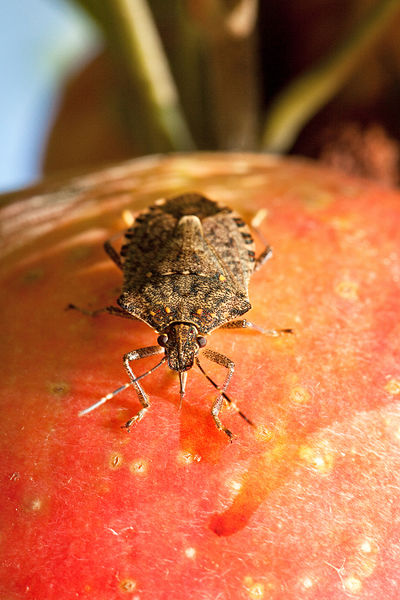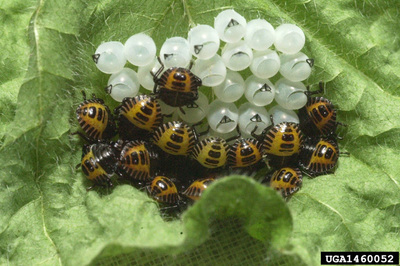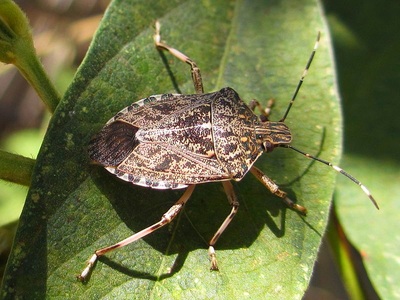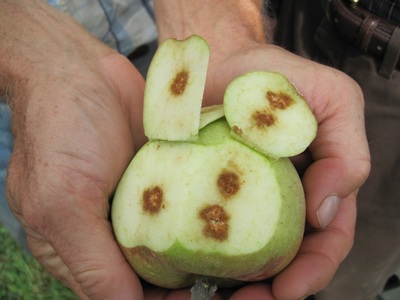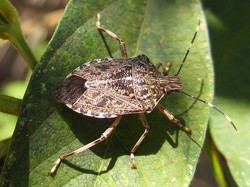
No one likes stink bugs. But one of their strongest opposers is the resident who walks into their living room, only to find dozens (if not hundreds) of the oddly-shaped insects taking advantage of the morning light by swarming all over the windows. Or, perhaps, the farmer who suddenly finds their crops decimated by a swarm of the pesky bugs.
In reality, the insect we call "stink bug" is actually the brown marmorated stink bug (Halyomorpha halys), a native of east Asia. The species was accidentally introduced to eastern Pennsylvania in the late 1990's, and has been spreading its way all over the continent ever since. Today, individual insects (if not entire breeding populations) have been sighted in every state east of the Mississippi River, and several states on the other side, as well. Population control is a priority of the Department of Agriculture, as well as several universities and other organizations.
Control is not easy, however. For one thing, the stink bug has no natural predators (although several local species of bird and predatory wasp have already clued in to this new food source). For another, because the insect inserts its proboscis below the surface of the fruit or vegetable its feeding on, insecticides laying on top of the skin of the plant are ineffective. Its large size and habit of holding itself above the ground also minimizes the effects that insecticides have on this pest.
WHAT YOU CAN DO
Make sure all cracks and holes are sealed with caulk or sealing foam, and that all window screens are secure and in good repair. Pay special attention to any cracks around windows, doors, siding, utility pipes, behind chimneys, and underneath the wood fascia and other openings. Any insects that make it in can be manually removed. Using a tissue, paper towel, or other product is usually best, as it minimizes the chance of the insect "stinking" into your hand. Vacuum cleaners are not recommended, as the strong smell produced by the panicked insects can seep into the mechanism and ruin the vacuum if the bag is left in the cleaner for too long.
OUR TREATMENT
For the reasons listed above, elimination is next to impossible. Rather, any treatments aim to cut back the number of insects, not eliminate them entirely. For that reason, the outside of the house is sprayed with a product we've had success with in regard to stink bugs. We pay special attention to windows, exterior doors, and other entry points.
In reality, the insect we call "stink bug" is actually the brown marmorated stink bug (Halyomorpha halys), a native of east Asia. The species was accidentally introduced to eastern Pennsylvania in the late 1990's, and has been spreading its way all over the continent ever since. Today, individual insects (if not entire breeding populations) have been sighted in every state east of the Mississippi River, and several states on the other side, as well. Population control is a priority of the Department of Agriculture, as well as several universities and other organizations.
Control is not easy, however. For one thing, the stink bug has no natural predators (although several local species of bird and predatory wasp have already clued in to this new food source). For another, because the insect inserts its proboscis below the surface of the fruit or vegetable its feeding on, insecticides laying on top of the skin of the plant are ineffective. Its large size and habit of holding itself above the ground also minimizes the effects that insecticides have on this pest.
WHAT YOU CAN DO
Make sure all cracks and holes are sealed with caulk or sealing foam, and that all window screens are secure and in good repair. Pay special attention to any cracks around windows, doors, siding, utility pipes, behind chimneys, and underneath the wood fascia and other openings. Any insects that make it in can be manually removed. Using a tissue, paper towel, or other product is usually best, as it minimizes the chance of the insect "stinking" into your hand. Vacuum cleaners are not recommended, as the strong smell produced by the panicked insects can seep into the mechanism and ruin the vacuum if the bag is left in the cleaner for too long.
OUR TREATMENT
For the reasons listed above, elimination is next to impossible. Rather, any treatments aim to cut back the number of insects, not eliminate them entirely. For that reason, the outside of the house is sprayed with a product we've had success with in regard to stink bugs. We pay special attention to windows, exterior doors, and other entry points.
Unless otherwise indicated, all photos are courtesy Wikimedia Commons or the US Centers for Disease Control and Prevention.

